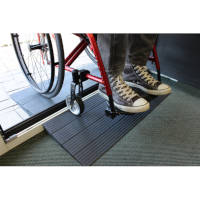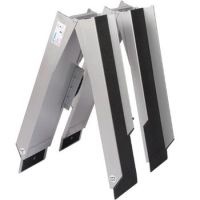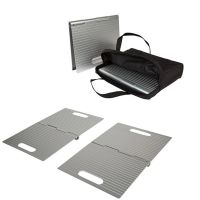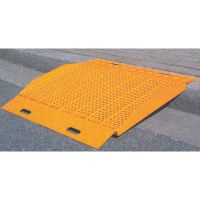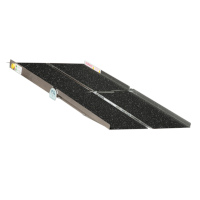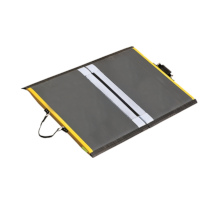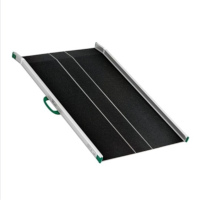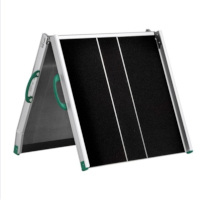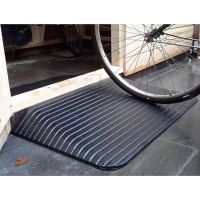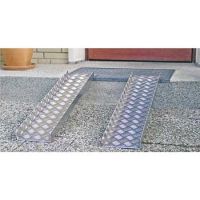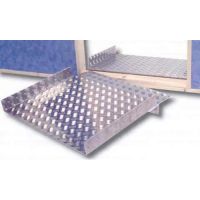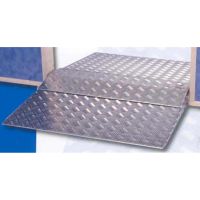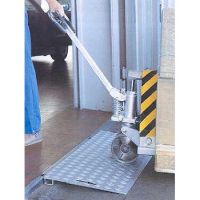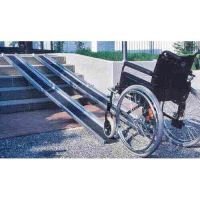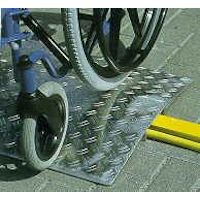Ramps
Ramps bridge landings, obstacles or steps. This avoids tripping hazards and removes obstacles for wheelchair users.
Stationary, permanently installed ramps are used for larger obstacles. Portable ramps are suitable for smaller height differences such as thresholds. Small ramps are available as rigid or foldable versions.
Portable ramps can be divided into 3 subgroups:
- Threshold ramps
These bridge small door thresholds. - Step ramps
These bridge several steps. The ramp rests on the top step or on intermediate steps. - Rail ramps
These consist of two separate lanes and can be rigid or telescopic in length. They are used to negotiate steps or to transfer to a car. The distance between the lanes can be determined individually.
Stationary ramps are permanently fixed and, depending on the model, can be folded up. The height to be overcome determines the length of the ramp. The gradient should not be higher than 6 % to enable independent negotiation. A ramp should end on a platform and, for long distances, have intermediate platforms for recovery breaks.
To ensure that ramps can be used with assurance, the maximum load should be taken into account when purchasing them. In addition, stationary ramps should have a railing and portable ramps should be positioned near railings. Many models have edge protection to prevent them from rolling sideways.
Only mobile ramps are assistive products as defined by statutory health insurance and can be found in the Statuatory Health Insurance's Medical Technical Aids Register under item number 22.50.01.0XXX.
know more
Products (47)
-
1 mobile ramp
Model: Teleskopierbare Anlegerampe quick2go Manufacturer: Rolko Kohlgrüber GmbH Distributor: Sanitäts-Fachhandel oder orthopädie-technischer Fachbetrieb -
2 stationary ramp
Model: Türschwellenrampe quick2go Manufacturer: Rolko Kohlgrüber GmbH Distributor: Sanitäts-Fachhandel oder orthopädie-technischer Fachbetrieb -
3 mobile ramp – step bridging
Model: Excellent Rampen-Set Care Slope Manufacturer: Excellent Systems A/S Distributor: T-RV Technik und Reha Vertriebs GmbH -
4 mobile ramp – step bridging
Model: Türschwellenrampe Luxus Manufacturer: keine Angaben Distributor: Roege International BV -
5 stationary ramp – step bridging
Model: Gummirampe, grau, mit / ohne Klebefläche Manufacturer: Mobilex A/S Distributor: Burbach + Goetz Deutsche Sanitätshaus GmbH | Sanitäts-Fachhandel oder orthopädie-technischer Fachbetrieb -
6 mobile ramp
Model: Zweifach faltbare Kofferrampe DF 180 / Zweifach faltbare Kofferrampe DF 240 / Zweifach faltbare Kofferrampe DF 300 Manufacturer: Mobilex A/S Distributor: Mobilex A/S -
7 mobile ramp
Model: FALTBARE AUFFAHRSCHIENE MODELL CH Manufacturer: Mobilex A/S Distributor: Mobilex A/S -
8 stationary ramp
Model: Lehmann Profilrampe Manufacturer: Lehmann Rollstuhlrampen & Hebelifte Distributor: Lehmann Rollstuhlrampen & Hebelifte -
9 mobile ramp – step bridging
Model: Doppelteilige DS Rampe DS4025 Manufacturer: Mobilex A/S Distributor: Mobilex A/S -
10 mobile ramp – step bridging
Model: Auffahrrampe PFF 750 - 2500 (starr) Manufacturer: PcP.-Sicherheitsroste GmbH Distributor: PcP.-Sicherheitsroste GmbH -
11 mobile ramp
Model: Auffahrrampe PFS 750 - 2500 (klappbar) Manufacturer: PcP.-Sicherheitsroste GmbH Distributor: PcP.-Sicherheitsroste GmbH -
12 stationary ramp
Model: AOL-R: Rutschfeste Rollstuhlrampe für Treppen / RLS: Rollstuhlrampe Modulsystem Manufacturer: ALTEC GmbH Distributor: ALTEC GmbH -
13 mobile ramp
Model: Feste Rampe Manufacturer: Guldmann GmbH Distributor: Guldmann GmbH -
14 mobile ramp
Model: Mehrfach faltbare Rampen Manufacturer: MEYRA GmbH Distributor: MEYRA GmbH -
15 mobile ramp
Model: Einfach faltbare Rampen Manufacturer: MEYRA GmbH Distributor: MEYRA GmbH -
16 mobile ramp
Model: Lite Rampen Manufacturer: Guldmann GmbH Distributor: Guldmann GmbH -
17 stationary ramp – step bridging
Model: Excellent Rampenkits Manufacturer: Guldmann GmbH Distributor: Guldmann GmbH -
18 mobile ramp
Model: Rampe Stepless 30020 klappbar Manufacturer: Guldmann GmbH Distributor: Guldmann GmbH -
19 mobile ramp – step bridging
Model: Türschwellenplatte Manufacturer: Guldmann GmbH Distributor: Guldmann GmbH -
20 mobile ramp
Model: Längenverschiebbare EasyFold Rampe Manufacturer: Guldmann GmbH Distributor: Guldmann GmbH -
21 mobile ramp
Model: Feste Rampe, breit Manufacturer: Guldmann GmbH Distributor: Guldmann GmbH -
22 mobile ramp
Model: Zusammenklappbare Rampe, breit Manufacturer: Guldmann GmbH Distributor: Guldmann GmbH -
23 mobile ramp
Model: Zusammenklappbare Teleskop-Rampen Manufacturer: Guldmann GmbH Distributor: Guldmann GmbH -
24 mobile ramp
Model: Wheelramp 1,2 m / 1,5 m Manufacturer: Fischer & Timme GbR Distributor: SOZIALHELDEN UG -
25 mobile ramp – step bridging
Model: Gummi-Türschwellenrampe Manufacturer: keine Angaben Distributor: Roege International BV -
26 mobile ramp
Model: Rampe TR-150, TR-210 Manufacturer: Mobilex A/S Distributor: Mobilex A/S -
27 mobile ramp
Model: Koffer Rampe SR-180, SR-240 Manufacturer: Mobilex A/S Distributor: Mobilex A/S -
28 mobile ramp
Model: Standardrampe Manufacturer: ATO FORM GmbH Distributor: ATO FORM GmbH -
29 stationary ramp
Model: Schwellenrampe Standard / Schwellenrampe hoch Manufacturer: ATO FORM GmbH Distributor: ATO FORM GmbH -
30 mobile ramp
Model: Rollerrampe Manufacturer: ATO FORM GmbH Distributor: ATO FORM GmbH -
31 wheelchair ramp – step bridging
Model: Außenrampen A-Rif Manufacturer: Mowi Systems KG Distributor: Mowi Systems KG -
32 mobile ramp
Model: Roll-A-Ramp Manufacturer: AHA GmbH Distributor: AHA GmbH -
33 mobile ramp – step bridging
Model: Mobile Türschwellenrampe Manufacturer: keine Angaben Distributor: Roege International BV -
34 mobile ramp – step bridging
Model: Gummi-Türschwellenrampe Budget Manufacturer: keine Angaben Distributor: Roege International BV -
35 mobile ramp
Model: Einfach faltbare Kofferrampe SF 40 / 90 / 120 / 150 Manufacturer: Mobilex A/S Distributor: Mobilex A/S -
36 mobile ramp – step bridging
Model: Rampe BTR Manufacturer: ALTEC GmbH Distributor: ALTEC GmbH -
37 mobile ramp
Model: Auffahrrampe Spurteile Manufacturer: Lehmann Rollstuhlrampen & Hebelifte Distributor: Lehmann Rollstuhlrampen & Hebelifte -
38 mobile ramp – step bridging
Model: Türschwellenblech einteilig, ohne Aufkantung Manufacturer: Lehmann Rollstuhlrampen & Hebelifte Distributor: Lehmann Rollstuhlrampen & Hebelifte -
39 mobile ramp – step bridging
Model: Türschwellenrampe zweiteilig, Aufkantung oben/unten Manufacturer: Lehmann Rollstuhlrampen & Hebelifte Distributor: Lehmann Rollstuhlrampen & Hebelifte -
40 mobile ramp – step bridging
Model: Türschwellenrampe dreiteilig, Aufkantung unten, dTSR-Au Manufacturer: Lehmann Rollstuhlrampen & Hebelifte Distributor: Lehmann Rollstuhlrampen & Hebelifte -
41 mobile ramp
Model: Auffahrschiene ABS Manufacturer: ALTEC GmbH Distributor: ALTEC GmbH -
42 mobile ramp – step bridging
Model: Türschwellenrampe SBK Manufacturer: ALTEC GmbH Distributor: ALTEC GmbH -
43 mobile ramp
Model: Rampe Verladerampe Manufacturer: Lehmann Rollstuhlrampen & Hebelifte Distributor: Lehmann Rollstuhlrampen & Hebelifte -
44 mobile ramp
Model: Teleskoprampe TR130, TR195, TR310, TR290 Manufacturer: Lehmann Rollstuhlrampen & Hebelifte Distributor: Lehmann Rollstuhlrampen & Hebelifte -
45 mobile ramp
Model: Stufenrampe Varianten Manufacturer: Lehmann Rollstuhlrampen & Hebelifte Distributor: Lehmann Rollstuhlrampen & Hebelifte -
46 mobile ramp – step bridging
Model: Türschwellenbrücke SBS Manufacturer: ALTEC GmbH Distributor: ALTEC GmbH -
47 mobile ramp – step bridging
Model: Türschwellenbrücke einteilig, Aufkantung oben Manufacturer: Lehmann Rollstuhlrampen & Hebelifte Distributor: Lehmann Rollstuhlrampen & Hebelifte


